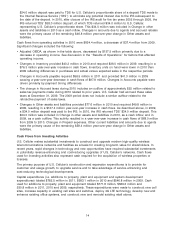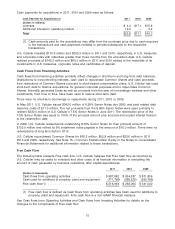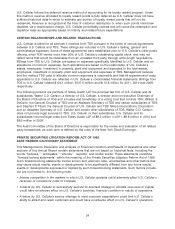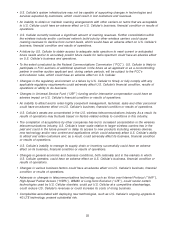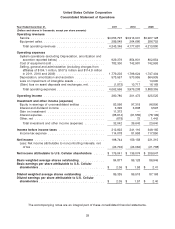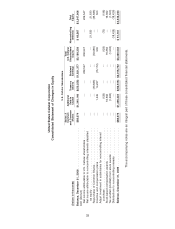US Cellular 2011 Annual Report Download - page 31
Download and view the complete annual report
Please find page 31 of the 2011 US Cellular annual report below. You can navigate through the pages in the report by either clicking on the pages listed below, or by using the keyword search tool below to find specific information within the annual report.Income Taxes
U.S. Cellular is included in a consolidated federal income tax return with other members of the TDS
consolidated group. TDS and U.S. Cellular are parties to a Tax Allocation Agreement which provides that
U.S. Cellular and its subsidiaries be included with the TDS affiliated group in a consolidated federal
income tax return and in state income or franchise tax returns in certain situations. For financial
statement purposes, U.S. Cellular and its subsidiaries calculate their income, income tax and credits as if
they comprised a separate affiliated group. Under the Tax Allocation Agreement, U.S. Cellular remits its
applicable income tax payments to TDS.
The amounts of income tax assets and liabilities, the related income tax provision and the amount of
unrecognized tax benefits are critical accounting estimates because such amounts are significant to U.S.
Cellular’s financial condition and results of operations.
The preparation of the consolidated financial statements requires U.S. Cellular to calculate its provision
for income taxes. This process involves estimating the actual current income tax liability together with
assessing temporary differences resulting from the different treatment of items for tax purposes. These
temporary differences result in deferred income tax assets and liabilities, which are included in U.S.
Cellular’s Consolidated Balance Sheet. U.S. Cellular must then assess the likelihood that deferred
income tax assets will be realized based on future taxable income and, to the extent management
believes that realization is not likely, establish a valuation allowance. Management’s judgment is required
in determining the provision for income taxes, deferred income tax assets and liabilities and any
valuation allowance that is established for deferred income tax assets.
U.S. Cellular recognizes the tax benefit from an uncertain tax position only if it is more likely than not that
the tax position will be sustained on examination by the taxing authorities, based on the technical merits
of the position. The tax benefits recognized in the financial statements from such a position are
measured based on the largest benefit that has a greater than 50% likelihood of being realized upon
ultimate resolution.
See Note 5—Income Taxes in the Notes to Consolidated Financial Statements for details regarding U.S.
Cellular’s income tax provision, deferred income taxes and liabilities, valuation allowances and
unrecognized tax benefits, including information regarding estimates that impact income taxes.
Allowance for Doubtful Accounts
U.S. Cellular’s accounts receivable primarily consist of amounts owed by customers pursuant to service
contracts and for equipment sales, by agents for sales of equipment to them and by other wireless
carriers whose customers have used U.S. Cellular’s wireless systems.
The allowance for doubtful accounts is the best estimate of the amount of probable credit losses related
to existing accounts receivable. The allowance is estimated based on historical experience and other
factors that could affect collectability. Accounts receivable balances are reviewed on either an aggregate
or individual basis for collectability depending on the type of receivable. When it is probable that an
account balance will not be collected, the account balance is charged against the allowance for doubtful
accounts. U.S. Cellular does not have any off-balance sheet credit exposure related to its customers.
U.S. Cellular will continue to monitor its accounts receivable balances and related allowance for doubtful
accounts on an ongoing basis to assess whether it has adequately provided for potentially uncollectible
amounts.
See Note 1—Summary of Significant Accounting Policies and Recent Accounting Pronouncements in the
Notes to Consolidated Financial Statements for additional information regarding U.S. Cellular’s allowance
for doubtful accounts.
Loyalty Reward Program
See the Revenue Recognition section of Note 1—Summary of Significant Accounting Policies and Recent
Accounting Pronouncements in the Notes to Consolidated Financial Statements for a description of this
program and the related accounting.
23



